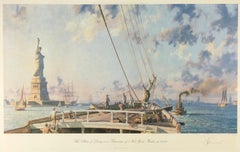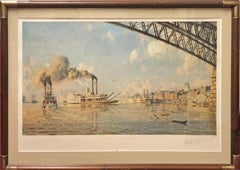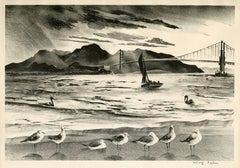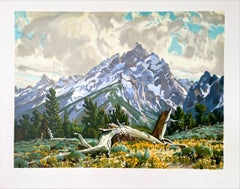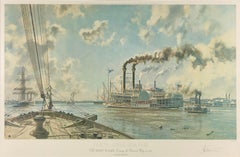John Stobart Art
British, 1929-2023
John Stobart was a British maritime artist known for his paintings of American harbor scenes during the Golden Age of Sail. His fascination with the sea stemmed from childhood visits to his grandmother in Liverpool where he observed the city's busy docks. After graduation, he travelled to Africa with his father and made sketches of the 12 ports he visited there, inspiring him to pursue maritime art as a specialty. Stobart emigrated to Canada in 1957 where his paintings sold well to the various shipping companies on the St. Lawrence River. In 1965 he made his first visit to the U.S. and was offered a show at the Kennedy Galleries. Later, he established the Stobart Foundation to encourage traditional artists through scholarships. He moved in 2015 to Fort Lauderdale, Florida which is where he died in 2023 at the age of 93.to
3
3
3
3
Dealer: Gallery of the Masters
The Statue of Liberty in a Panorama of New York City in 1886
By John Stobart
Located in Missouri, MO
John Stobart
"The Statue of Liberty in a Panorama of New York City in 1886"
Color Lithograph
approx 32 x 43 inches framed
Signed in Pencil and Numbered 914/950
A marine painter of ...
Category
1970s American Realist John Stobart Art
Materials
Lithograph
A View of St. Louis
By John Stobart
Located in Missouri, MO
John Stobart
"St. Louis, A View Through the Arches of the Eads Bridge" 1979
Color Lithograph
32.5 x 37.5 inches framed
Signed in Pencil and Numbered 221/75...
Category
1970s American Realist John Stobart Art
Materials
Lithograph
St. Louis, Gateway to the West
By John Stobart
Located in Missouri, MO
John Stobart
"St. Louis, Gateway to the West"
Color Lithograph
30 x 42 inches framed
Signed in Pencil and Numbered 434/750
Category
1970s American Realist John Stobart Art
Materials
Lithograph
Related Items
The Golden Gate
By Adolf Arthur Dehn
Located in Fairlawn, OH
The Golden Gate
Lithograph on wove paper watermarked GC, 1940
Signed in pencil by the artist (see photo)
Publisher: Associated American Artists
Edition: 189, unnumbered
The image depicts The Golden Gate Bridge which connects San Francisco and Marin County, California
References And Exhibitions:
Illustrated: Adams, The Sensuous Life of Adolf Dehn, Fig. 13.17, page 324
Reference: L & O 325
AAA Index 391
Adolf Dehn, American Watercolorist and Printmaker, 1895-1968
Adolf Dehn was an artist who achieved extraordinary artistic heights, but in a very particular artistic sphere—not so much in oil painting as in watercolor and lithography. Long recognized as a master by serious print collectors, he is gradually gaining recognition as a notable and influential figure in the overall history of American art.
In the 19th century, with the invention of the rotary press, which made possible enormous print runs, and the development of the popular, mass-market magazines, newspaper and magazine illustration developed into an artistic realm of its own, often surprisingly divorced from the world of museums and art exhibitions, and today remains surprisingly overlooked by most art historians. Dehn in many regards was an outgrowth of this world, although in an unusual way, since as a young man he produced most of his illustrative work not for popular magazines, such as The Saturday Evening Post, but rather for radical journals, such as The Masses or The Liberator, or artistic “little magazines” such as The Dial. This background established the foundation of his outlook, and led later to his unique and distinctive contribution to American graphic art.
If there’s a distinctive quality to his work, it was his skill in introducing unusual tonal and textural effects into his work, particularly in printmaking but also in watercolor. Jackson Pollock seems to have been one of many notable artists who were influenced by his techniques.
Early Years, 1895-1922
For an artist largely remembered for scenes of Vienna and Paris, Adolf Dehn’s background was a surprising one. Born in Waterville, Minnesota, on November 22, 1895, Dehn was the descendent of farmers who had emigrated from Germany and homesteaded in the region, initially in a one-room log cabin with a dirt floor. Adolf’s father, Arthur Clark Dehn, was a hunter and trapper who took pride that he had no boss but himself, and who had little use for art. Indeed, during Adolf’s boyhood the walls of his bedroom and the space under his bed were filled with the pelts of mink, muskrats and skunks that his father had killed, skinned and stretched on drying boards. It was Adolf’s mother, Emilie Haas Dehn, a faithful member of the German Lutheran Evangelical Church, who encouraged his interest in art, which became apparent early in childhood. Both parents were ardent socialists, and supporters of Eugene Debs. In many ways Dehn’s later artistic achievement was clearly a reaction against the grinding rural poverty of his childhood.
After graduating from high school in 1914 at the age of 19—an age not unusual in farming communities at the time, where school attendance was often irregular—Dehn attended the Minneapolis School of Art from 1914 to 1917, whose character followed strongly reflected that of its director, Munich-trained Robert Kohler, an artistic conservative but a social radical. There Dehn joined a group of students who went on to nationally significant careers, including Wanda Gag (later author of best-selling children’s books); John Flanagan (a sculptor notable for his use of direct carving) Harry Gottlieb (a notable social realist and member of the Woodstock Art Colony), Elizabeth Olds (a printmaker and administrator for the WPA), Arnold Blanch (landscape, still-life and figure painter, and member of the Woodstock group), Lucille Lunquist, later Lucille Blanch (also a gifted painter and founder of the Woodstock art colony), and Johan Egilrud (who stayed in Minneapolis and became a journalist and poet).
Adolf became particularly close to Wanda Gag (1893-1946), with whom he established an intense but platonic relationship. Two years older than he, Gag was the daughter of a Bohemian artist and decorator, Anton Gag, who had died in 1908. After her husband died, Wanda’s mother, Lizzi Gag, became a helpless invalid, so Wanda was entrusted with the task of raising and financially supporting her six younger siblings. This endowed her with toughness and an independent streak, but nonetheless, when she met Dehn, Wanda was Victorian and conventional in her artistic taste and social values. Dehn was more socially radical, and introduced her to radical ideas about politics and free love, as well as to socialist publications such as The Masses and The Appeal to Reason.
Never very interested in oil painting, in Minneapolis Dehn focused on caricature and illustration--often of a humorous or politically radical character. In 1917 both Dehn and Wanda won scholarships to attend the Art Students League, and consequently, in the fall of that year both moved to New York. Dehn’s art education, however, ended in the summer of 1918, shortly after the United States entered World War I, when he was drafted to serve in the U. S. Army. Unwilling to fight, he applied for status as a conscientious objector, but was first imprisoned, then segregated in semi-imprisonment with other Pacifists, until the war ended. The abuse he suffered at this time may well explain his later withdrawal from taking political stands or making art of an overtly political nature. After his release from the army, Dehn returned to New York where he fell under the spell of the radical cartoonist Boardman Robinson and produced his first lithographs. He also finally consummated his sexual relationship with Wanda Gag.
The Years in Europe: 1922-1929
In September of 1921, however, he abruptly departed for Europe, arriving in Paris and then moving on to Vienna. There in the winter of 1922 he fell in love with a Russian dancer, Mura Zipperovitch, ending his seven-year relationship with Wanda Gag. He and Mura were married in 1926. It was also in Vienna that he produced his first notable artistic work.
Influenced by European artists such as Jules Pascin and Georg Grosz, Dehn began producing drawings of people in cafes, streets, and parks, which while mostly executed in his studio, were based on spontaneous life studies and have an expressive, sometimes almost childishly wandering quality of line. The mixture of sophistication and naiveté in these drawings was new to American audiences, as was the raciness of their subject matter, which often featured pleasure-seekers, prostitutes or scenes of sexual dalliance, presented with a strong element of caricature. Some of these drawings contain an element of social criticism, reminiscent of that found in the work of George Grosz, although Dehn’s work tended to focus on humorous commentary rather than savagely attacking his subjects or making a partisan political statement. Many Americans, including some who had originally been supporters of Dehn such as Boardman Robinson, were shocked by these European drawings, although George Grocz (who became a friend of the artist in this period) admired them, and recognized that Dehn could also bring a new vision to America subject matter. As he told Dehn: “You will do things in America which haven’t been done, which need to be done, which only you can do—as far at least as I know America.”
A key factor in Dehn’s artistic evolution at this time was his association with Scofield Thayer...
Category
1940s American Realist John Stobart Art
Materials
Lithograph
TAPESTRY OF SPRING Hand Drawn Lithograph Grand Tetons Wyoming Mountain Landscape
By Conrad Schwiering 1
Located in Union City, NJ
TAPESTRY OF SPRING by the American Western artist Conrad Schwiering, is a hand drawn limited edition lithograph printed using hand lithography techniques on archival Somerset paper 1...
Category
1980s American Realist John Stobart Art
Materials
Lithograph
Cooling Off, American Western Art Lithograph by Duane Bryers
By Duane Bryers
Located in Long Island City, NY
Duane Bryers, American (1911 - 2012) - Cooling Off, Year: 1979, Medium: Lithograph, Signed and Numbered in Pencil, Edition: 300, AP, Image Size: 17.5 x 22.5 inches, Size: 21.5 i...
Category
1970s American Realist John Stobart Art
Materials
Lithograph
Late July 2
By Alex Katz
Located in Toronto, Ontario
Alex Katz (b. 1927) has been dedicated to art-making since the 1950's - however, it wasn't until the 60's when he established his signature 'flat' figurative style. Over the succeedi...
Category
1970s American Realist John Stobart Art
Materials
Lithograph
Ann Nooney, (Demolition with Windows, NYC)
By Ann Nooney
Located in New York, NY
The dimensions are for the image; there are large margins. This lithograph is signed in pencil.
A native New Yorker, Ann Nooney (1900-1970) recorded the urban scene while on the Wo...
Category
1930s American Realist John Stobart Art
Materials
Lithograph
Going Home, Modern Black and White Lithograph by Georges Schreiber
By Georges Schreiber
Located in Long Island City, NY
Artist: Georges Schreiber, Belgian/American (1904 - 1977)
Title: Going Home
Year: circa 1945
Medium: Lithograph, signed and titled in pencil
Image Size: 9.25 x 13.25 inches
Size: 12 ...
Category
1940s American Realist John Stobart Art
Materials
Lithograph
Pay Dirt, American Western Art Lithograph by Noel Daggett
By Noel Daggett
Located in Long Island City, NY
Noel Daggett, American (1925 - 2005) - Pay Dirt, Year: circa 1979, Medium: Lithograph, signed and numbered in pencil, Edition: 300, AP 40, Image Size: 20 x 24.5 inches, Size: 22...
Category
1970s American Realist John Stobart Art
Materials
Lithograph
$250
H 22 in W 29.5 in
Backyard II
By Robert Kipniss
Located in Fairlawn, OH
Backyard II
Lithograph, 1972
Signed lower right
Signed lower right
Annotated: Printer's Proof
Reference: Karl Lunde 58
An impression is in the collection of the Art Institute of Chic...
Category
1970s American Realist John Stobart Art
Materials
Lithograph
Green River, American Western Art Lithograph by Duane Bryers
By Duane Bryers
Located in Long Island City, NY
Duane Bryers, American (1911 - 2012) - Green River, Year: 1979, Medium: Lithograph, signed and numbered in pencil, Edition: 300, AP, Image Size: 17 x 22.5 inches, Size: 21.5 in....
Category
1970s American Realist John Stobart Art
Materials
Lithograph
MISSOURI MOUSE - Large Folio "The Viviparous Quadrupeds of North America" Pl.100
By After John James Audubon
Located in Santa Monica, CA
(After) JOHN JAMES AUDUBON (1785 - 1851)
MISSOURI MOUSE, 1846 - Plate 100 (C) No. 20
Lithograph with original hand coloring. From Audubon's "The Viviparous Quadrupeds of North America...
Category
1840s American Realist John Stobart Art
Materials
Lithograph
$600 Sale Price
20% Off
H 16 in W 22 in
"Winter's Over" barn scene by Owen Wexler
Located in Chesterfield, MI
Winter is serene in this landscape of a barn in winter as it begins to fade and head to spring.
Owen Wexler is the artist; this is a limited edition lithograph signed and titled by him.
Category
Mid-20th Century American Realist John Stobart Art
Materials
Lithograph
"Winter's Over" barn scene by Owen Wexler
Located in Chesterfield, MI
Winter is serene in this landscape of a barn in winter as it begins to fade and head to spring.
Owen Wexler is the artist; this is a limited edition lithograph signed and titled by him.
Category
Mid-20th Century American Realist John Stobart Art
Materials
Lithograph
Previously Available Items
San Pedro, The Bark "Vidette" Towing into Port at Sunrise, 1890
By John Stobart
Located in Missouri, MO
John Stobart
"San Pedro, The Bark 'Vidette' Towing into Port at Sunrise, 1890"
Color Lithograph
Approx. 33 x 41 Framed
Signed in Pencil and Numbered 463/750
...
Category
1970s American Realist John Stobart Art
Materials
Lithograph
New Orleans - Robert E. Lee Leaving the Crescent City in 1880
By John Stobart
Located in Missouri, MO
John Stobart
"New Orleans - Robert E. Lee Leaving the Crescent City in 1880"
Color Lithograph
33 x 45 inches famed
Signed in Pencil and Numbered 642/750
A marine painter of harbor ...
Category
1970s American Realist John Stobart Art
Materials
Lithograph
Hannibal - View from Mark Twain's Boyhood Home
By John Stobart
Located in Missouri, MO
John Stobart
"Hannibal - A View from Mark Twain's Boyhood Home"
Color Lithograph
Signed in Pencil and Numbered 582/750
A marine painter of harbor scenes and ship portraits, John Sto...
Category
1970s American Realist John Stobart Art
Materials
Lithograph
John Stobart art for sale on 1stDibs.
Find a wide variety of authentic John Stobart available for sale on 1stDibs. You can also browse by medium to find art by John Stobart in lithograph and more. Not every interior allows for large John Stobart, so small editions measuring 27 inches across are available. Customers who are interested in this artist might also find the work of Frank Wootton, Warrington Colescott, and Neil Welliver. John Stobart prices can differ depending upon medium, time period and other attributes. On 1stDibs, the price for these items starts at $425 and tops out at $1,500, while the average work can sell for $1,250.
